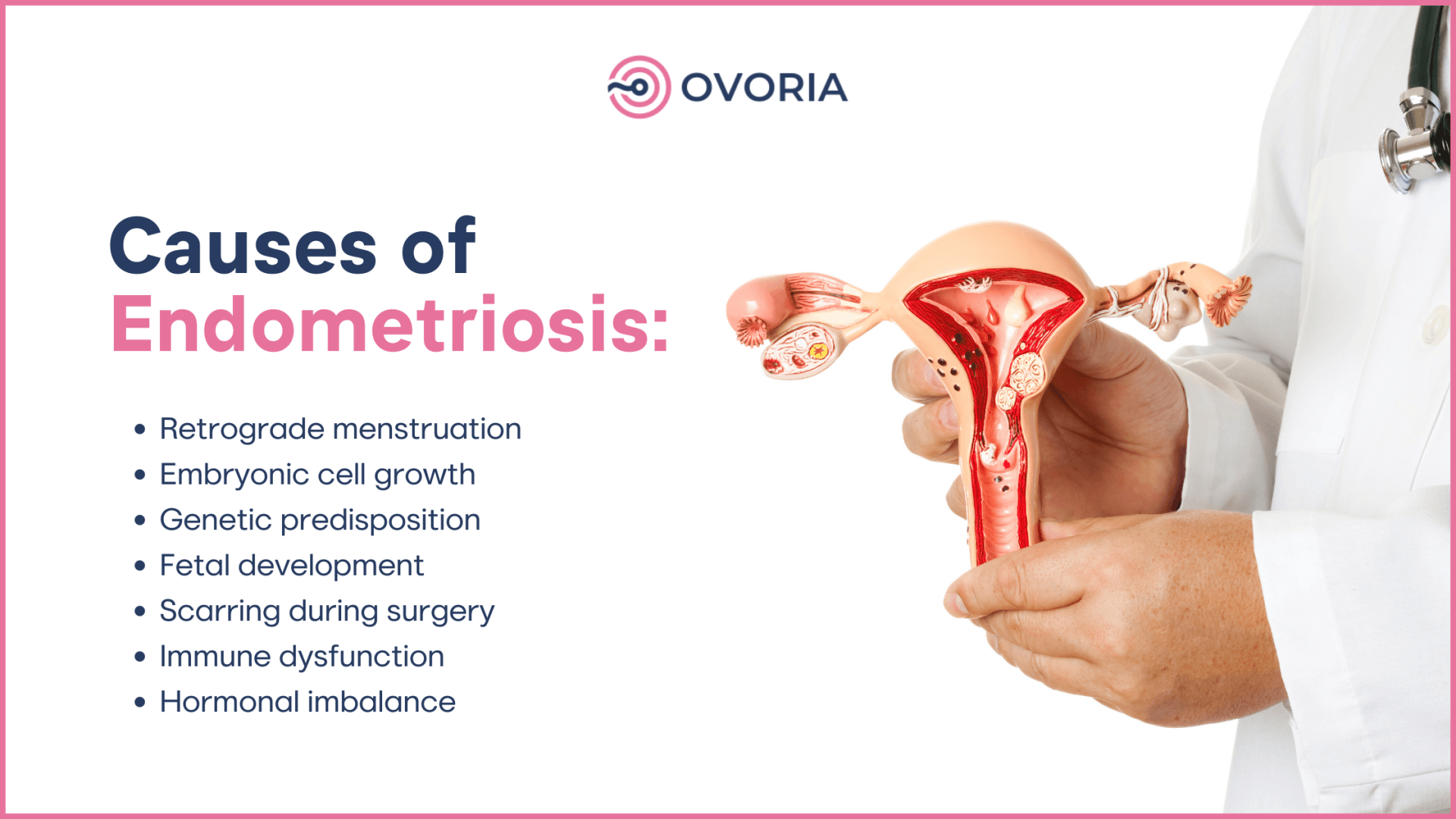What Causes Endometriosis?
While several theories explain what causes endometriosis, its aetiology remains inconclusive. About 10% of women of childbearing age have endometriosis globally; hence, it's a crucial topic. This comprehensive outline enlightens you about endometriosis, its causes, common symptoms, and the available treatment options. Please keep reading to find out more!

What is Endometriosis?
Endometriosis occurs due to the ectopic development of tissue similar to the lining of your womb. Endometriosis tissue grows outside the uterus, often on the ovaries, fallopian tubes, bowel, pelvis, and behind the uterus. In rare cases, this tissue may spread beyond the pelvic region and implant on your lungs, bladder, cervix, and other body parts.
In regular menstrual cycles, the endometrium thickens to support a potential pregnancy. If pregnancy doesn't happen, the endometrium sheds and exits through the vagina during your periods.
Despite the location of the endometrial tissue, it keeps on responding to hormonal fluctuations during the menstrual cycle, leading to cyclic menstrual-type bleeding in the affected organs. However, unlike your standard menstrual periods, this blood gets trapped in the pelvic cavity, causing intermittent inflammation and swelling.
Hence, endometriosis causes agonising painful menstruation. The recurrent bleeding may cause scarring, fibrous tissue, and chocolate cysts formation. Over time, the growths can expand and distort your pelvic organs, causing infertility. In some cases, endometriosis can cause ovarian cysts called endometriomas.
Though endometriosis can significantly affect your everyday life, your doctor can prescribe effective treatments to relieve symptoms.
Symptoms of Endometriosis
The severity of symptoms of endometriosis depends on the location of the endometrial tissue and varies from woman to woman. However, some women remain asymptomatic. Sometimes, physicians discover it during other procedures, like an infertility examination. The primary symptoms include:
Pelvic Pain
The most noticeable sign of endometriosis is pelvic pain. The pain may start just before your menstruation, last during, and sometimes a few days after the menstrual period. If you have endometriosis, you may experience different types of pain, which include:
- Severe menstrual cramps (dysmenorrhea), which worsen over time
- Long-term lower back and pelvic pain that heightens during periods.
- Persistent painful intercourse (dyspareunia) or occurring after intercourse
- Painful urination (dysuria) or pain when pooping (dyschezia), especially during menstruation. Occasionally, you may see blood in your urine (hematuria) or stool (hematochezia).
There's no link between the severity of your pain and the degree of the condition. You may have agonising pain with a mild form of the disease. You may also have little discomfort with a severe stage of the disease. Either way, your gynaecologist can help you alleviate symptoms and pain.
Menstrual Irregularities
Endometriosis may display through unusual menstrual abnormalities like heavy menstrual periods (menorrhagia), intermenstrual spotting or bleeding (metrorrhagia), and periods lasting more than seven days.
However, other conditions, such as Pelvic Inflammatory Disease (PID), may cause menstrual irregularities. Therefore, if these irregularities occur often, you should schedule a pelvic examination to establish the cause.
Infertility
Studies have revealed that doctors often diagnose endometriosis in women experiencing difficulty conceiving. Therefore, it remains one of the leading causes of female infertility. Ectopic endometrial tissue may block your fallopian tubes and prevent eggs from reaching the uterus, reducing your chances of getting pregnant.
In some cases, it may lead to hormonal changes and impaired implantation. Suppose you have unexplained difficulty conceiving with other signs of endometriosis. In that case, your fertility doctor can help establish a suitable solution for a successful pregnancy.
Bowel/Digestive Problems
Besides discomfort with bowel movements, you may also experience diarrhoea, bloating, nausea, or vomiting, particularly during your periods.
What Causes Endometriosis?
The true cause of endometriosis is unknown. However, research points out certain factors contributing to its development. Common explanations behind endometriosis aetiology include
Never Giving Birth
Nulliparity or never giving birth increases the risk of developing endometriosis. Nulliparous women have more exposure to menstruation and oestrogen hormones than multiparous women.
Oestrogen hormones and oestrogen-like substances influence endometriosis. Every month during your menstrual cycle, you get oestrogen exposure. Pregnancy stops your periods for up to nine months, reducing this exposure and risk of endometriosis.
Some studies suggest that the risk is up to 10 times lower. Also, having more children can reduce the risk even more.
Frequent Menstrual Cycles
Specific problems with your menstrual flow, such as short and frequent menstruation, can increase your risk of developing endometriosis. You will likely develop endometriosis if you have monthly cycles shorter than 27 days or if your periods last seven days or longer. Besides, women whose first menstruation (menarche) starts before age 11 may develop endometriosis due to early exposure to the hormone oestrogen.
High Levels of Oestrogen
Endometriosis is primarily an oestrogen-dependent condition. Oestrogen triggers inflammation, facilitating disease progression. When oestrogen levels increase abnormally, it may lead to excessive endometrial cell growth, increasing the chances of disease development.
Low BMI
Studies have established that women with a lower BMI (less than 18.5kg/m2) have a higher risk of endometriosis. A high BMI may lead to insulin resistance and hyperinsulinemia, which increase the production of adrenal androgens. Increased androgen levels reduce your risk of endometriosis.
Besides, high BMI contributes to infrequent or absent menstruation, decreasing the risk of endometriosis.
Genetic Factors
Studies have discovered that endometriosis runs in some families. Therefore, genetic factors contribute to its development. If you have a first-degree family member with endometriosis, you may have a higher risk of acquiring the genes.
Having distant relations, such as aunties with endometriosis, also increases the probability of developing this condition. You can inherit endometriosis from both maternal and paternal sides.
Immune System Dysfunction
The immune system protects your body from diseases. Suppose you have a faulty or weak immune system. In that case, it may fail to detect and destroy/stop the ectopic endometrial cells. As a result, you may experience inflammation and develop lesions and scar tissue. Women with rheumatoid arthritis or inflammatory bowel disease (IBD) have a higher risk of developing endometriosis.
Exposure to Environmental Toxins
Research shows that environmental toxins, such as organochlorine pesticides and dioxins, cause endometriosis. Additionally, if you have exposure to polychlorinated biphenyls (PCBs), you may have a higher risk of developing endometriosis.
Retrograde Menstruation
Sometimes, when you have your menstruation, some endometrial cells that shed may travel back through the fallopian/uterine tubes to the pelvic cavity. This phenomenon is known as retrograde or reverse menstruation.Then, the cells may get implanted and grow, resulting in endometriosis. However, retrograde menstruation occurs in many women, and the body's immune system clears most of these cells.
Treatment Options for Endometriosis
Currently, there's no cure for endometriosis. However, various treatment options exist to manage symptoms and prevent endometriosis complications like infertility. The goal of endometriosis treatment is to:
- Relieve pain
- Improve fertility
- Remove the ectopic endometrial tissue
- Lower chances of reoccurrence
- Prevent complications of endometriosis
Treatment options vary depending on symptoms' severity, age, and personal preference. Discuss the benefits and risks with your doctor before treatment.
Sometimes, treatment may be unnecessary if you have mild symptoms, have no fertility issues, or are in the perimenopausal stage, where symptoms could disappear without treatment. Treatment methods for endometriosis include:
Pain Medication
Your doctor may prescribe you pain-relieving medication. Pain relievers that can help reduce endometriosis-related pain include:
- Non-steroidal anti-inflammatory drugs (NSAIDs) include ibuprofen, diclofenac, voltarol, and mefenamic acid.
- Simple analgesics such as paracetamol to treat mild pain
- Opioid-based painkillers for severe pain.
Inform your doctor if the pain doesn't improve within a few weeks. They may prescribe alternative medication.
Hormone Therapy
Hormone-based treatments suppress hormone production in the ovaries, preventing ovulation and stopping the menstrual period and thickening of the endometrium. Some standard hormone therapy options include:
- Combined oral contraceptives (COCs)
- Intrauterine devices (IUCDs)
- Vaginal contraceptive ring
- Gonadotropin-releasing hormone analogs
- Progestogens
Some women experience menopause-like symptoms such as sweating and hot flashes while using hormone therapy. Therefore, you may need to start on low doses. It's important to note that symptoms improve only when using the treatment; if you stop, the symptoms may return.
Hormone treatment is, however, not suitable for pregnant women or those desiring pregnancy. Studies show that hormone treatment may cause congenital malformations and difficulty achieving pregnancy. However, hormone therapy doesn't permanently affect your fertility; it is reversible once you stop the treatment.
Your fertility healthcare provider can help you determine if hormone treatment is proper for you after evaluating your symptoms.
Surgery
Your doctor may recommend surgery to destroy or remove endometriosis tissue and improve symptoms. The type of surgery depends on the size and location of the growth. Sometimes, doctors combine surgery with other treatment methods, such as hormone therapy. Standard surgical procedures for treating the disease include:
Laparoscopy (Keyhole Surgery)
Laparoscopy is a relatively gentle surgical procedure where the surgeon makes a small incision in your abdomen. The process involves using a tube-like instrument called a laparoscope and other instruments to view inside your body and cut/destroy the lesions.
In this approach, doctors remove the endometrial tissue through general anesthesia so you don't feel any pain during the procedure. Moreover, research shows that the removal of endometriosis using laparoscopy improves fertility.
Laparotomy
Alternatively, your doctor may use laparotomy, a major surgical procedure that cuts through the abdominal wall. Usually, doctors recommend laparotomy for severe endometriosis or if it is untreatable by laparoscopy.
Hysterectomy
In rare cases, doctors may advise hysterectomy, an irreversible surgical procedure, when other treatment options are unsuccessful. Although it's not the first treatment option for severe endometriosis, it's a standard treatment involving surgical uterine removal.
Hysterectomy is recommendable in women with other uterine conditions like adenomyosis, a form of endometriosis where the endometrial-like tissue invades the muscular wall of the uterus.There are three types of hysterectomies including:
- Partial hysterectomy – Removal of the uterus but not ovaries and cervix
- Total hysterectomy – Removal of the uterus and cervix
- Hysterectomy and oophorectomy – Removal of the uterus and one or both ovaries
Talk to your specialist about other treatment options if you desire pregnancy. Hysterectomy may not be the right option as it involves removing the uterus, and you won't carry a pregnancy afterward.
Complementary Treatments and Alternative Medicine
Several treatment methods can complement the current medical treatment. This treatment involves relieving pain with approaches such as:
- Traditional Chinese medicine
- Acupuncture
- Herbs and supplements
- Chiropractic care
- Mind-body practices like meditation and yoga
Some women report improvement in symptoms with these approaches. If you decide to use some of these complementary and alternative treatments, discuss them with your doctor before using them since they may interfere with other medications.
Lifestyle Changes
Regular physical exercises, a balanced diet, a healthy sleep schedule, and stress management can help you cope and relieve symptoms of endometriosis.
Conclusion
Endometriosis is a chronic gynaecological condition that can significantly affect your daily life. Studies are still ongoing to establish the exact cause of endometriosis. Some common symptoms include menstrual irregularities, difficulty achieving pregnancy, and chronic pain.
While there's no identified cure for endometriosis, some medications, surgery, alternative medicine, and lifestyle changes can relieve pain and manage symptoms. Hopefully, this article has helped you understand what causes endometriosis and take the right action to help improve your quality of life.
References
- Vercellini, P., Viganò, P., Somigliana, E., & Fedele, L. (2014). Endometriosis: pathogenesis and treatment. Nature Reviews Endocrinology, 10(5), 261-275. Retrieved from https://www.nature.com/articles/nrendo.2013.255
- Endometriose | Kinderwunschklinik InviMed. (n.d.). Www.invimed.de. Retrieved January 12, 2024, from https://www.invimed.de/endometriose
- Benagiano, G., Brosens, I., & Lippi, D. (2014). The history of endometriosis. Gynecologic and obstetric investigation, 78(1), 1-9. Retrieved from https://karger.com/goi/article-abstract/78/1/1/149444/The-History-of-Endometriosis

